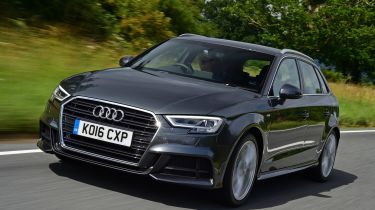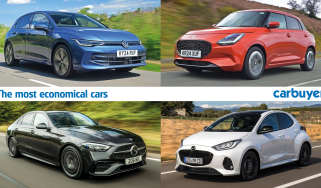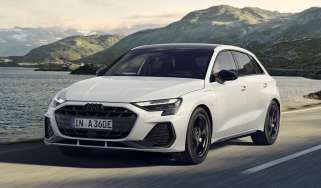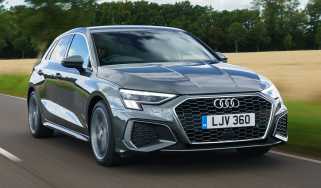Used Audi A3 review: 2012 to 2020 (Mk3) - Engines, performance and drive
The Audi A3 isn’t as good to drive as a BMW 1 Series, but it’s more comfortable and easier to drive than a Mercedes A-Class
The Audi A3 sits somewhere in the middle of its rivals when it comes to handling and driving. It’s a good all-rounder, with decent grip and enough comfort for most, but it doesn’t excel in any one area. The BMW 1 Series, for example, is sharper to drive, while a VW Golf is more comfortable (but not by much).
Go for a lower-spec model such as SE for the best ride quality, as the smaller wheels and softer suspension are better at dealing with bumps. The S Line models came with stiffer suspension as standard, unless the original owner selected the free-of-charge SE suspension instead.
What is the Audi A3 like to drive?
The Audi A3 has predictable handling, a comfortable and quiet ride with minimal body lean in corners, plus smooth and effortless performance. Confidence-inspiring four-wheel-drive grip is available with the quattro version, but all others are front-wheel drive. The BMW 1 Series Mk2 is better to drive, though, and brings rear-wheel-drive to the table, a unique selling point.
The Audi A3 Sportback’s petrol and diesel engines are notable for their smooth and punchy power delivery, so deciding between them may come down to their respective economy and emissions figures.
There really is an engine for all tastes, with the smaller petrols providing a good blend of price and performance, while the diesels suit higher-mileage motorists who want good economy with effortless cruising ability, or those who need to tow a caravan.
More reviews
There are manual or automatic options and they are both good: the manual is slick and easy to use, while the auto box is smooth and makes driving more relaxing.
The plug-in hybrid e-tron only comes with the six-speed automatic gearbox, which struggles when the car has to transition between the pure petrol and pure electric modes – on occasion it can be quite clunky.
In the e-tron model, the suspension is quite firm to keep the car from leaning too much in corners, but the extra weight of the batteries is noticeable, and the e-tron isn't really a car intended to be driven quickly regularly. If you go for large alloy wheels, the suspension set-up means bumps, potholes and cat’s eyes will all be very noticeable inside the car.
Which engine should I choose?
Drivers looking for easy around-town driving and respectable fuel economy should consider the entry-level 1.0-litre ‘30 TFSI’. It produces 114bhp, which is enough to propel the car from 0-62mph in 9.9 seconds. The power is well spread over the rev range too, offering plenty of oomph from low to high revs. It's also a remarkably refined engine, quieter than many of its rivals, while its relative lightness makes the A3 peppy and quite fun to drive.
Unsurprisingly, the 1.5-litre 35 TFSI’s 148bhp provides slightly improved performance and, given the car’s balance of price and efficiency, it’s our pick of the range. The cylinder-on-demand (half the engine shuts down under light throttle) 1.5-litre TFSI is a relaxed cruiser, and it feels sporty, with 0-62mph taking just 8.2 seconds. The 187bhp 2.0-litre 40 TFSI takes just 6.8 seconds, but fuel economy takes a hit.
The older engines follow along the same lines. The 2.0-litre is punchy but not very economical, the 1.2-litre is a tiny, quiet engine that’s pretty economical but a bit slow, and the 1.4-litre model provides the best of both worlds. If you want a pre-2016 A3 then the 1.4-litre model is best.
The A3 Sportback’s diesel engines bring good performance and excellent fuel economy, although low-mileage drivers should weigh up their higher purchase price compared with those of the equivalent petrol cars. The 1.6-litre 30 TDI produces 114bhp and sprints from 0-62mph in a respectable 10.4 seconds. Performance improves with the 148bhp 2.0-litre 35 TDI, which does 0-62mph in 8.6 seconds (or 8.1 seconds with the S tronic automatic gearbox).
The Audi A3 e-tron is a plug-in hybrid that combines a 148bhp 1.4-litre TFSI petrol engine with a 101bhp electric motor for a total output of 201bhp. The 0-62mph sprint time is dealt with in a brisk 7.6 seconds, owing to the instant power delivered by the electric motor at low speeds.
Before the e-tron was facelifted in mid-2016, there was a mode that allowed the petrol engine to act partially as a generator to top up the batteries for the electric motor. Audi decided this affected fuel economy too negatively, so now there are three modes; a pure electric mode, a hybrid mode and a mode that conserves battery power so the electric motor can be prioritised for use in urban areas.
















